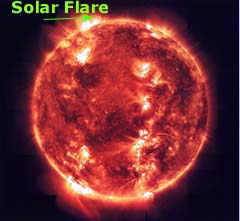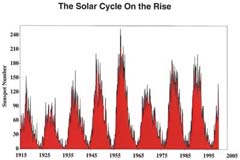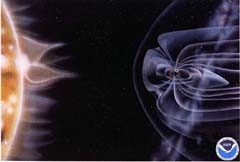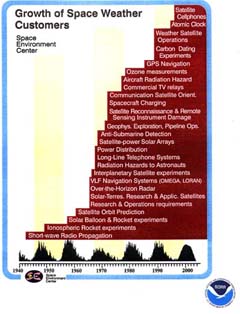|
NEW NOAA SPACE WEATHER SCALES MAKE SOLAR MAX EFFECTS MORE PREDICTABLE
As the period during the 11-year
solar cycle when the sun is most active, Solar Maximum brings
an increase in the number and intensity of solar storms and their
effects. Space storms, radiation showers, aurora borealis, and
affects on power grids and Global Positioning System navigation
and other systems are all expected during the upcoming Solar
Max period, which is expected to last about three years. Working like the Richter scale for earthquakes, NOAA's new space weather scales describe the intensity and frequency of three kinds of solar events: geomagnetic storms, solar radiation storms and radio blackouts. "The scales are a giant step forward in informing the public about the severity of these events and their expected consequences," said Dr. Ernie Hildner, director of NOAA's Space Environment Center in Boulder, Colorado. Hildner said that physical measurements on the scales will help the scientific and operations communities consistently identify the intensity of solar events. Solar storms can vary, with some equivalent to a thunderstorm on Earth, while others may be more severe, with intensity similar to a hurricane or tornado. Satellite expert David Desrocher, a senior engineer at The Aerospace Corporation in Colorado Springs, Colorado, said that, "NOAA's new space weather scales will significantly aid the space industry in anticipating events, understanding effects, and developing more robust satellite designs and mitigation strategies." John Kappenman, a senior engineer at Metatech in Duluth, Minn., explained that space storms can impact the operational reliability of electrical transmission systems world-wide. "The previous solar cycle demonstrated just how seriously the power industry needs to consider the potential impacts of geomagnetic storms," Kappenman said. One of the strongest impacts occurred during the last solar cycle in 1989, when the entire Province of Quebec went dark because a geomagnetic storm caused power lines to overload. NOAA's Space Environment Center in Boulder is responsible for issuing warnings, watches and forecasts of the space environment and potential impacts on Earth. The Center continuously monitors the solar environment with a complex array of ground-based observations and satellites operated by NOAA and its national and international partners. For more information on the
Space Environment Center, check out www.spaceweather.noaa.gov NOAA'S
SPACE WEATHER INSTRUMENTS
|



